COMR2010 - Reflective Journal on Cultural Diversity: Personal View
VerifiedAdded on 2022/10/11
|5
|1423
|7
Homework Assignment
AI Summary
This assignment is a reflective journal exploring cultural diversity from a personal perspective, drawing on the student's experiences moving from Hong Kong to Australia. The paper delves into the importance of cultural awareness, sensitivity, and understanding in cross-cultural communication, emphasizing the need to adapt and embrace different viewpoints. It discusses key concepts like empathy, sympathy, and compassion, and addresses issues related to cultural diversity in the workplace, such as communication, respect, and the benefits of diversity. The assignment introduces the theory of border crossing, explaining its strategies and applications in fostering cooperation and understanding across cultural boundaries. The student reflects on the importance of open-mindedness, introspection, and empathy in navigating a culturally diverse world, highlighting the value of these principles for innovation, problem-solving, and harmonious living.
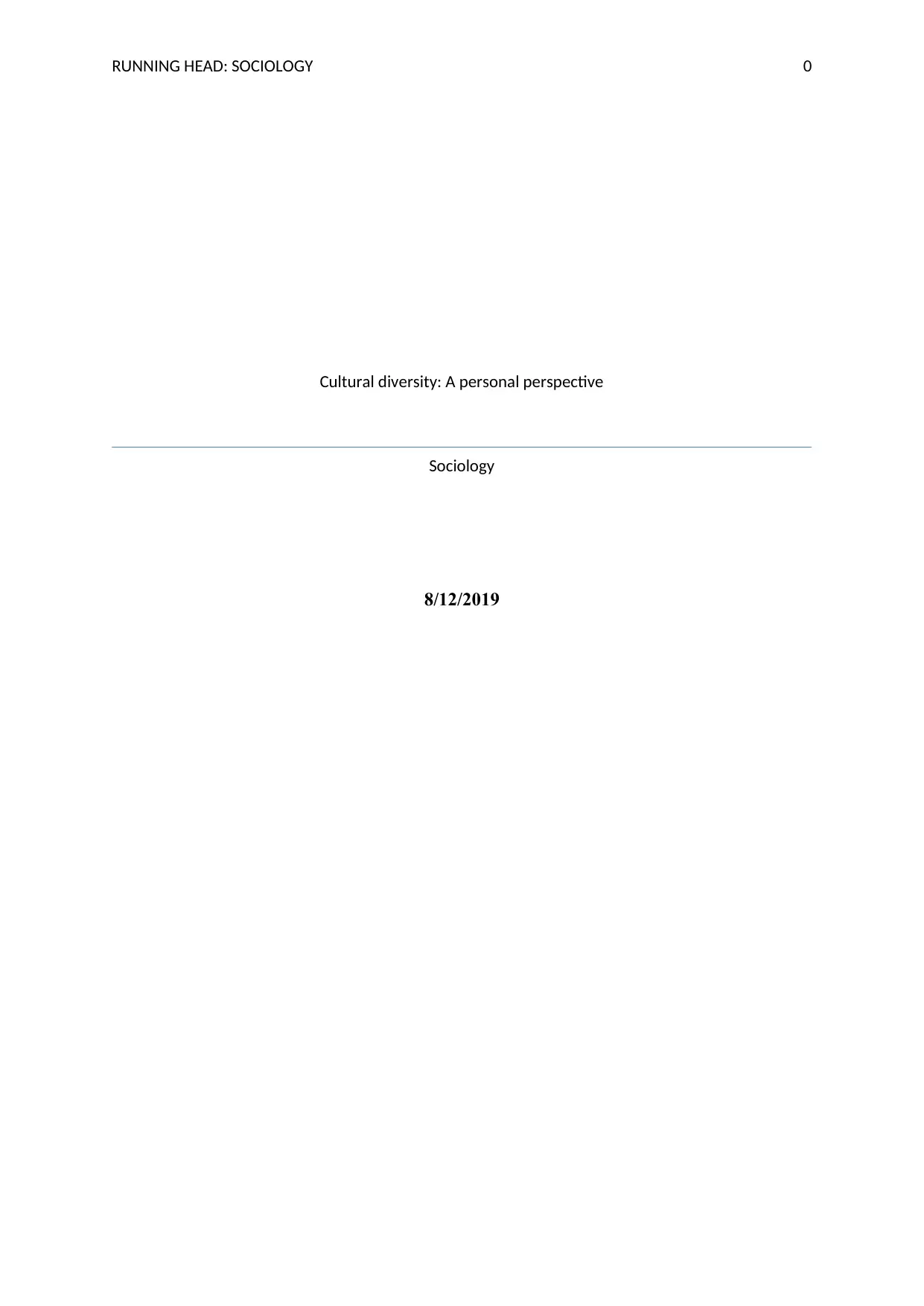
RUNNING HEAD: SOCIOLOGY 0
Cultural diversity: A personal perspective
Sociology
8/12/2019
Cultural diversity: A personal perspective
Sociology
8/12/2019
Paraphrase This Document
Need a fresh take? Get an instant paraphrase of this document with our AI Paraphraser
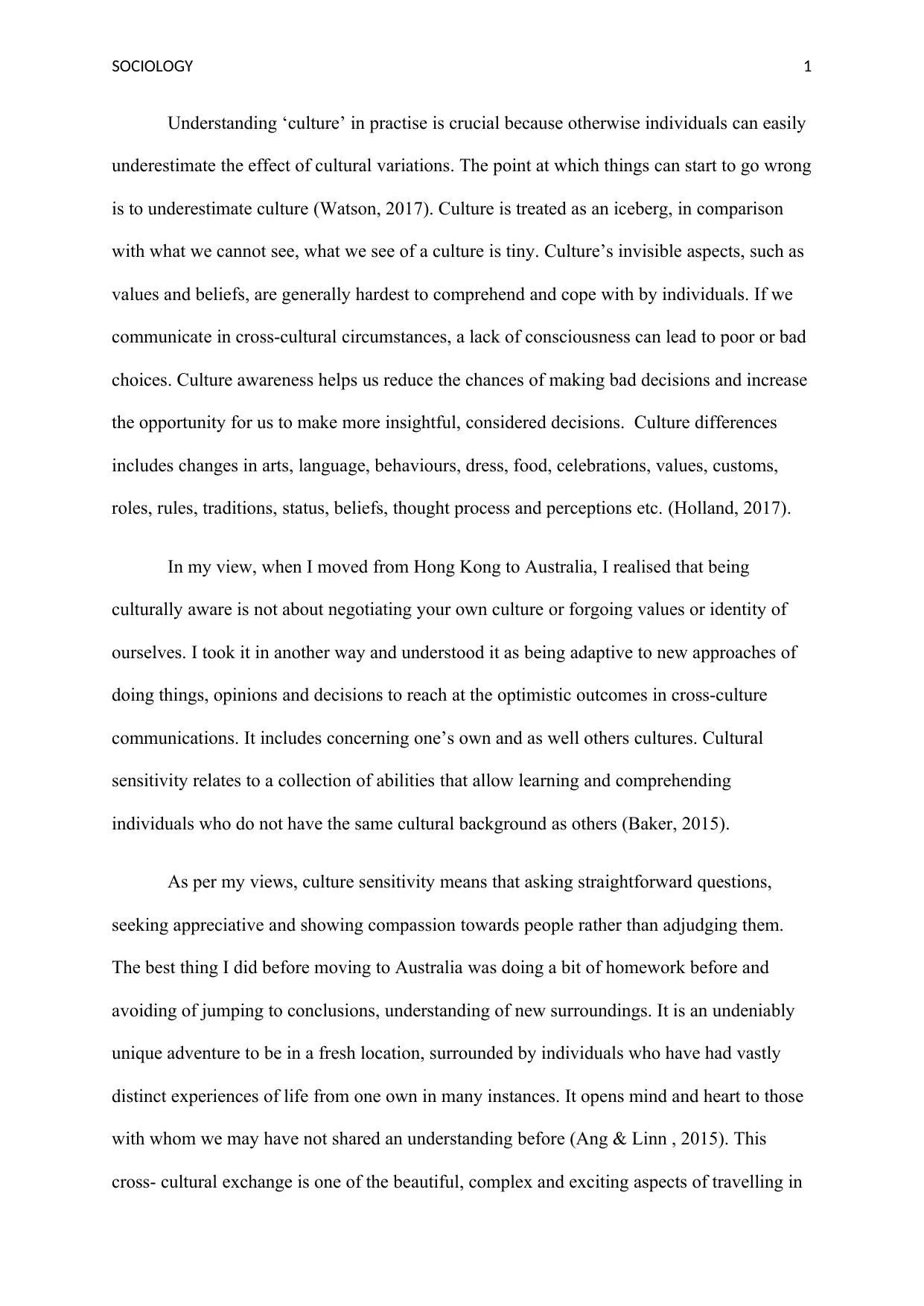
SOCIOLOGY 1
Understanding ‘culture’ in practise is crucial because otherwise individuals can easily
underestimate the effect of cultural variations. The point at which things can start to go wrong
is to underestimate culture (Watson, 2017). Culture is treated as an iceberg, in comparison
with what we cannot see, what we see of a culture is tiny. Culture’s invisible aspects, such as
values and beliefs, are generally hardest to comprehend and cope with by individuals. If we
communicate in cross-cultural circumstances, a lack of consciousness can lead to poor or bad
choices. Culture awareness helps us reduce the chances of making bad decisions and increase
the opportunity for us to make more insightful, considered decisions. Culture differences
includes changes in arts, language, behaviours, dress, food, celebrations, values, customs,
roles, rules, traditions, status, beliefs, thought process and perceptions etc. (Holland, 2017).
In my view, when I moved from Hong Kong to Australia, I realised that being
culturally aware is not about negotiating your own culture or forgoing values or identity of
ourselves. I took it in another way and understood it as being adaptive to new approaches of
doing things, opinions and decisions to reach at the optimistic outcomes in cross-culture
communications. It includes concerning one’s own and as well others cultures. Cultural
sensitivity relates to a collection of abilities that allow learning and comprehending
individuals who do not have the same cultural background as others (Baker, 2015).
As per my views, culture sensitivity means that asking straightforward questions,
seeking appreciative and showing compassion towards people rather than adjudging them.
The best thing I did before moving to Australia was doing a bit of homework before and
avoiding of jumping to conclusions, understanding of new surroundings. It is an undeniably
unique adventure to be in a fresh location, surrounded by individuals who have had vastly
distinct experiences of life from one own in many instances. It opens mind and heart to those
with whom we may have not shared an understanding before (Ang & Linn , 2015). This
cross- cultural exchange is one of the beautiful, complex and exciting aspects of travelling in
Understanding ‘culture’ in practise is crucial because otherwise individuals can easily
underestimate the effect of cultural variations. The point at which things can start to go wrong
is to underestimate culture (Watson, 2017). Culture is treated as an iceberg, in comparison
with what we cannot see, what we see of a culture is tiny. Culture’s invisible aspects, such as
values and beliefs, are generally hardest to comprehend and cope with by individuals. If we
communicate in cross-cultural circumstances, a lack of consciousness can lead to poor or bad
choices. Culture awareness helps us reduce the chances of making bad decisions and increase
the opportunity for us to make more insightful, considered decisions. Culture differences
includes changes in arts, language, behaviours, dress, food, celebrations, values, customs,
roles, rules, traditions, status, beliefs, thought process and perceptions etc. (Holland, 2017).
In my view, when I moved from Hong Kong to Australia, I realised that being
culturally aware is not about negotiating your own culture or forgoing values or identity of
ourselves. I took it in another way and understood it as being adaptive to new approaches of
doing things, opinions and decisions to reach at the optimistic outcomes in cross-culture
communications. It includes concerning one’s own and as well others cultures. Cultural
sensitivity relates to a collection of abilities that allow learning and comprehending
individuals who do not have the same cultural background as others (Baker, 2015).
As per my views, culture sensitivity means that asking straightforward questions,
seeking appreciative and showing compassion towards people rather than adjudging them.
The best thing I did before moving to Australia was doing a bit of homework before and
avoiding of jumping to conclusions, understanding of new surroundings. It is an undeniably
unique adventure to be in a fresh location, surrounded by individuals who have had vastly
distinct experiences of life from one own in many instances. It opens mind and heart to those
with whom we may have not shared an understanding before (Ang & Linn , 2015). This
cross- cultural exchange is one of the beautiful, complex and exciting aspects of travelling in
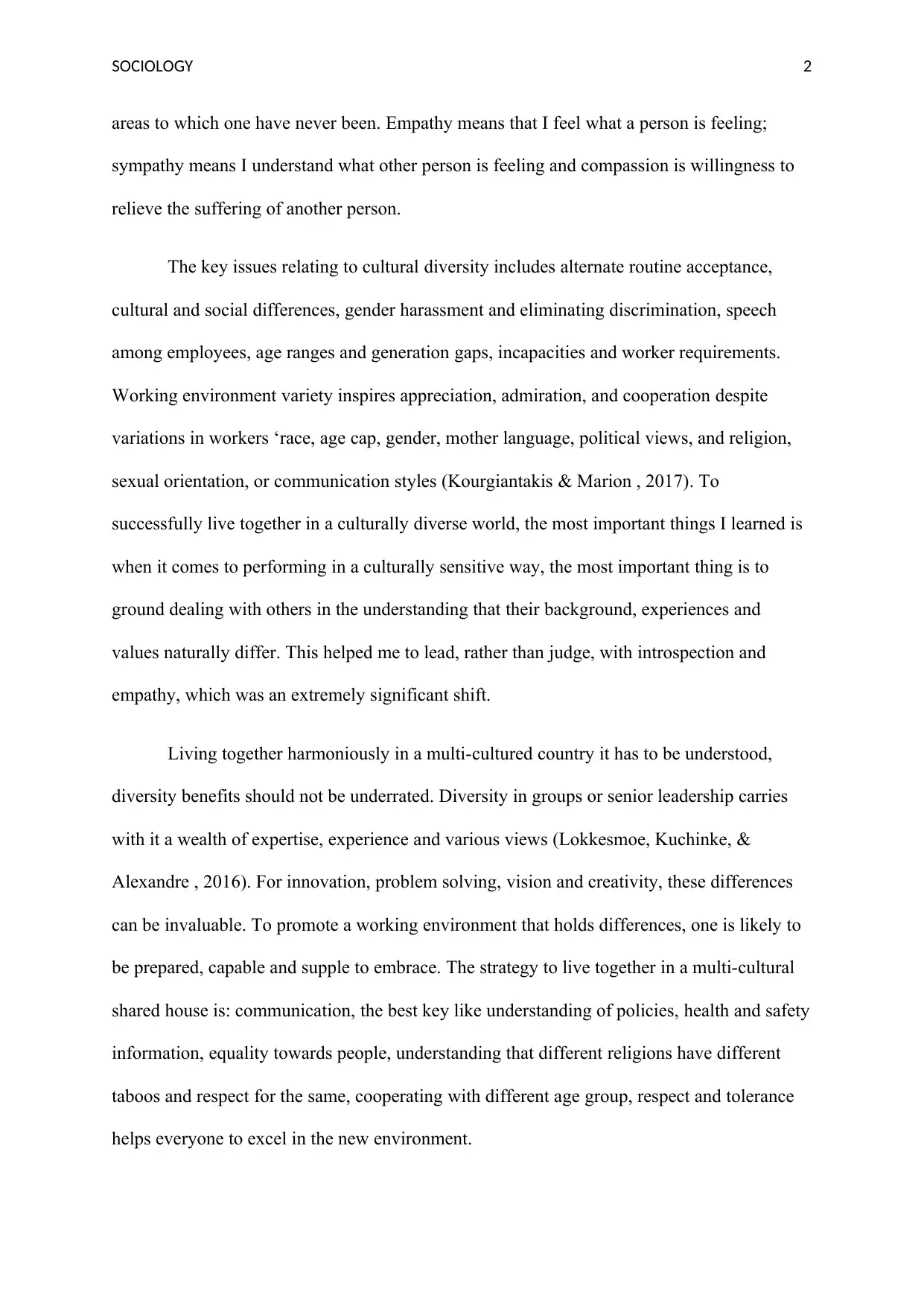
SOCIOLOGY 2
areas to which one have never been. Empathy means that I feel what a person is feeling;
sympathy means I understand what other person is feeling and compassion is willingness to
relieve the suffering of another person.
The key issues relating to cultural diversity includes alternate routine acceptance,
cultural and social differences, gender harassment and eliminating discrimination, speech
among employees, age ranges and generation gaps, incapacities and worker requirements.
Working environment variety inspires appreciation, admiration, and cooperation despite
variations in workers ‘race, age cap, gender, mother language, political views, and religion,
sexual orientation, or communication styles (Kourgiantakis & Marion , 2017). To
successfully live together in a culturally diverse world, the most important things I learned is
when it comes to performing in a culturally sensitive way, the most important thing is to
ground dealing with others in the understanding that their background, experiences and
values naturally differ. This helped me to lead, rather than judge, with introspection and
empathy, which was an extremely significant shift.
Living together harmoniously in a multi-cultured country it has to be understood,
diversity benefits should not be underrated. Diversity in groups or senior leadership carries
with it a wealth of expertise, experience and various views (Lokkesmoe, Kuchinke, &
Alexandre , 2016). For innovation, problem solving, vision and creativity, these differences
can be invaluable. To promote a working environment that holds differences, one is likely to
be prepared, capable and supple to embrace. The strategy to live together in a multi-cultural
shared house is: communication, the best key like understanding of policies, health and safety
information, equality towards people, understanding that different religions have different
taboos and respect for the same, cooperating with different age group, respect and tolerance
helps everyone to excel in the new environment.
areas to which one have never been. Empathy means that I feel what a person is feeling;
sympathy means I understand what other person is feeling and compassion is willingness to
relieve the suffering of another person.
The key issues relating to cultural diversity includes alternate routine acceptance,
cultural and social differences, gender harassment and eliminating discrimination, speech
among employees, age ranges and generation gaps, incapacities and worker requirements.
Working environment variety inspires appreciation, admiration, and cooperation despite
variations in workers ‘race, age cap, gender, mother language, political views, and religion,
sexual orientation, or communication styles (Kourgiantakis & Marion , 2017). To
successfully live together in a culturally diverse world, the most important things I learned is
when it comes to performing in a culturally sensitive way, the most important thing is to
ground dealing with others in the understanding that their background, experiences and
values naturally differ. This helped me to lead, rather than judge, with introspection and
empathy, which was an extremely significant shift.
Living together harmoniously in a multi-cultured country it has to be understood,
diversity benefits should not be underrated. Diversity in groups or senior leadership carries
with it a wealth of expertise, experience and various views (Lokkesmoe, Kuchinke, &
Alexandre , 2016). For innovation, problem solving, vision and creativity, these differences
can be invaluable. To promote a working environment that holds differences, one is likely to
be prepared, capable and supple to embrace. The strategy to live together in a multi-cultural
shared house is: communication, the best key like understanding of policies, health and safety
information, equality towards people, understanding that different religions have different
taboos and respect for the same, cooperating with different age group, respect and tolerance
helps everyone to excel in the new environment.
⊘ This is a preview!⊘
Do you want full access?
Subscribe today to unlock all pages.

Trusted by 1+ million students worldwide
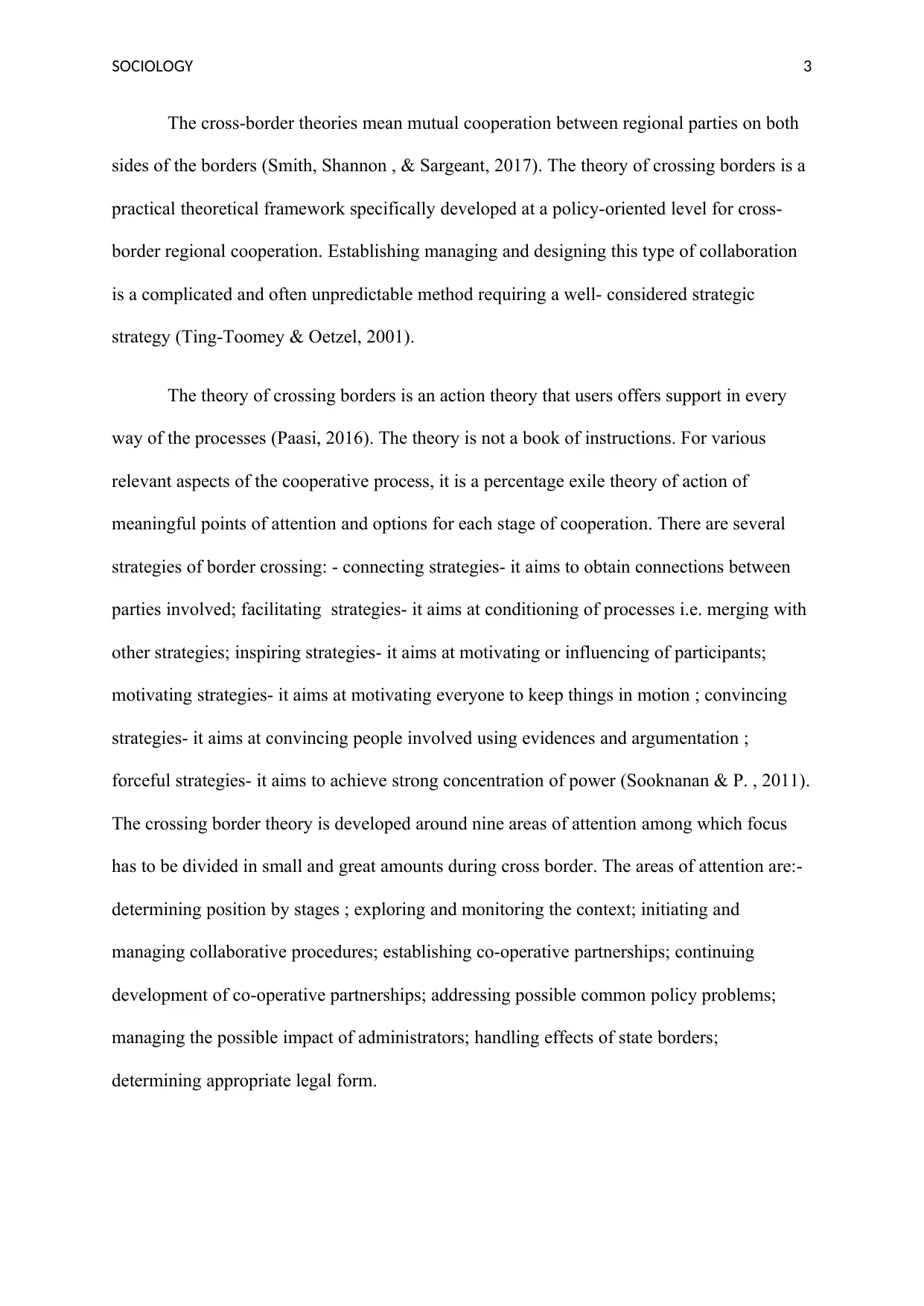
SOCIOLOGY 3
The cross-border theories mean mutual cooperation between regional parties on both
sides of the borders (Smith, Shannon , & Sargeant, 2017). The theory of crossing borders is a
practical theoretical framework specifically developed at a policy-oriented level for cross-
border regional cooperation. Establishing managing and designing this type of collaboration
is a complicated and often unpredictable method requiring a well- considered strategic
strategy (Ting-Toomey & Oetzel, 2001).
The theory of crossing borders is an action theory that users offers support in every
way of the processes (Paasi, 2016). The theory is not a book of instructions. For various
relevant aspects of the cooperative process, it is a percentage exile theory of action of
meaningful points of attention and options for each stage of cooperation. There are several
strategies of border crossing: - connecting strategies- it aims to obtain connections between
parties involved; facilitating strategies- it aims at conditioning of processes i.e. merging with
other strategies; inspiring strategies- it aims at motivating or influencing of participants;
motivating strategies- it aims at motivating everyone to keep things in motion ; convincing
strategies- it aims at convincing people involved using evidences and argumentation ;
forceful strategies- it aims to achieve strong concentration of power (Sooknanan & P. , 2011).
The crossing border theory is developed around nine areas of attention among which focus
has to be divided in small and great amounts during cross border. The areas of attention are:-
determining position by stages ; exploring and monitoring the context; initiating and
managing collaborative procedures; establishing co-operative partnerships; continuing
development of co-operative partnerships; addressing possible common policy problems;
managing the possible impact of administrators; handling effects of state borders;
determining appropriate legal form.
The cross-border theories mean mutual cooperation between regional parties on both
sides of the borders (Smith, Shannon , & Sargeant, 2017). The theory of crossing borders is a
practical theoretical framework specifically developed at a policy-oriented level for cross-
border regional cooperation. Establishing managing and designing this type of collaboration
is a complicated and often unpredictable method requiring a well- considered strategic
strategy (Ting-Toomey & Oetzel, 2001).
The theory of crossing borders is an action theory that users offers support in every
way of the processes (Paasi, 2016). The theory is not a book of instructions. For various
relevant aspects of the cooperative process, it is a percentage exile theory of action of
meaningful points of attention and options for each stage of cooperation. There are several
strategies of border crossing: - connecting strategies- it aims to obtain connections between
parties involved; facilitating strategies- it aims at conditioning of processes i.e. merging with
other strategies; inspiring strategies- it aims at motivating or influencing of participants;
motivating strategies- it aims at motivating everyone to keep things in motion ; convincing
strategies- it aims at convincing people involved using evidences and argumentation ;
forceful strategies- it aims to achieve strong concentration of power (Sooknanan & P. , 2011).
The crossing border theory is developed around nine areas of attention among which focus
has to be divided in small and great amounts during cross border. The areas of attention are:-
determining position by stages ; exploring and monitoring the context; initiating and
managing collaborative procedures; establishing co-operative partnerships; continuing
development of co-operative partnerships; addressing possible common policy problems;
managing the possible impact of administrators; handling effects of state borders;
determining appropriate legal form.
Paraphrase This Document
Need a fresh take? Get an instant paraphrase of this document with our AI Paraphraser
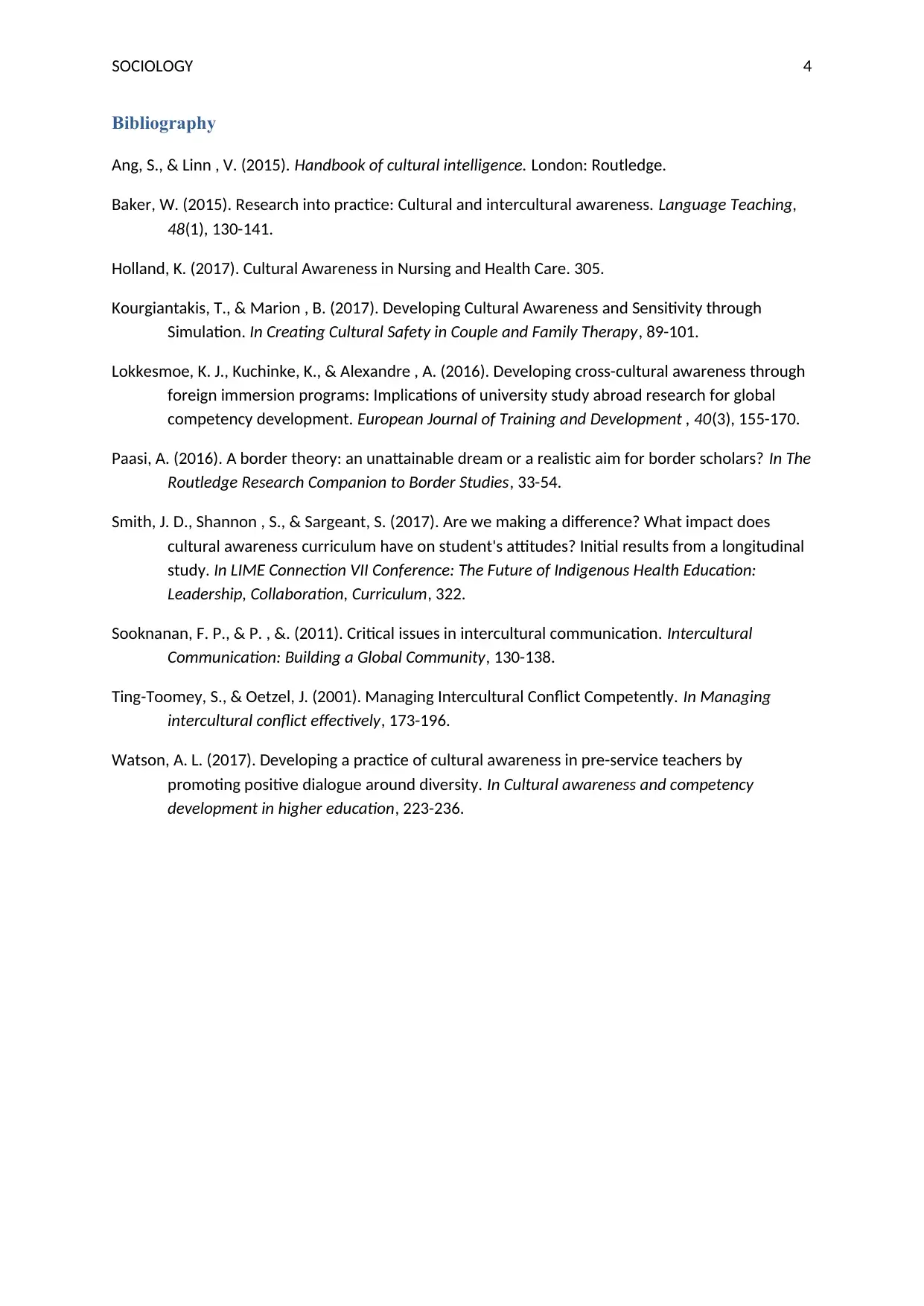
SOCIOLOGY 4
Bibliography
Ang, S., & Linn , V. (2015). Handbook of cultural intelligence. London: Routledge.
Baker, W. (2015). Research into practice: Cultural and intercultural awareness. Language Teaching,
48(1), 130-141.
Holland, K. (2017). Cultural Awareness in Nursing and Health Care. 305.
Kourgiantakis, T., & Marion , B. (2017). Developing Cultural Awareness and Sensitivity through
Simulation. In Creating Cultural Safety in Couple and Family Therapy, 89-101.
Lokkesmoe, K. J., Kuchinke, K., & Alexandre , A. (2016). Developing cross-cultural awareness through
foreign immersion programs: Implications of university study abroad research for global
competency development. European Journal of Training and Development , 40(3), 155-170.
Paasi, A. (2016). A border theory: an unattainable dream or a realistic aim for border scholars? In The
Routledge Research Companion to Border Studies, 33-54.
Smith, J. D., Shannon , S., & Sargeant, S. (2017). Are we making a difference? What impact does
cultural awareness curriculum have on student's attitudes? Initial results from a longitudinal
study. In LIME Connection VII Conference: The Future of Indigenous Health Education:
Leadership, Collaboration, Curriculum, 322.
Sooknanan, F. P., & P. , &. (2011). Critical issues in intercultural communication. Intercultural
Communication: Building a Global Community, 130-138.
Ting-Toomey, S., & Oetzel, J. (2001). Managing Intercultural Conflict Competently. In Managing
intercultural conflict effectively, 173-196.
Watson, A. L. (2017). Developing a practice of cultural awareness in pre-service teachers by
promoting positive dialogue around diversity. In Cultural awareness and competency
development in higher education, 223-236.
Bibliography
Ang, S., & Linn , V. (2015). Handbook of cultural intelligence. London: Routledge.
Baker, W. (2015). Research into practice: Cultural and intercultural awareness. Language Teaching,
48(1), 130-141.
Holland, K. (2017). Cultural Awareness in Nursing and Health Care. 305.
Kourgiantakis, T., & Marion , B. (2017). Developing Cultural Awareness and Sensitivity through
Simulation. In Creating Cultural Safety in Couple and Family Therapy, 89-101.
Lokkesmoe, K. J., Kuchinke, K., & Alexandre , A. (2016). Developing cross-cultural awareness through
foreign immersion programs: Implications of university study abroad research for global
competency development. European Journal of Training and Development , 40(3), 155-170.
Paasi, A. (2016). A border theory: an unattainable dream or a realistic aim for border scholars? In The
Routledge Research Companion to Border Studies, 33-54.
Smith, J. D., Shannon , S., & Sargeant, S. (2017). Are we making a difference? What impact does
cultural awareness curriculum have on student's attitudes? Initial results from a longitudinal
study. In LIME Connection VII Conference: The Future of Indigenous Health Education:
Leadership, Collaboration, Curriculum, 322.
Sooknanan, F. P., & P. , &. (2011). Critical issues in intercultural communication. Intercultural
Communication: Building a Global Community, 130-138.
Ting-Toomey, S., & Oetzel, J. (2001). Managing Intercultural Conflict Competently. In Managing
intercultural conflict effectively, 173-196.
Watson, A. L. (2017). Developing a practice of cultural awareness in pre-service teachers by
promoting positive dialogue around diversity. In Cultural awareness and competency
development in higher education, 223-236.
1 out of 5
Related Documents
Your All-in-One AI-Powered Toolkit for Academic Success.
+13062052269
info@desklib.com
Available 24*7 on WhatsApp / Email
![[object Object]](/_next/static/media/star-bottom.7253800d.svg)
Unlock your academic potential
Copyright © 2020–2025 A2Z Services. All Rights Reserved. Developed and managed by ZUCOL.




